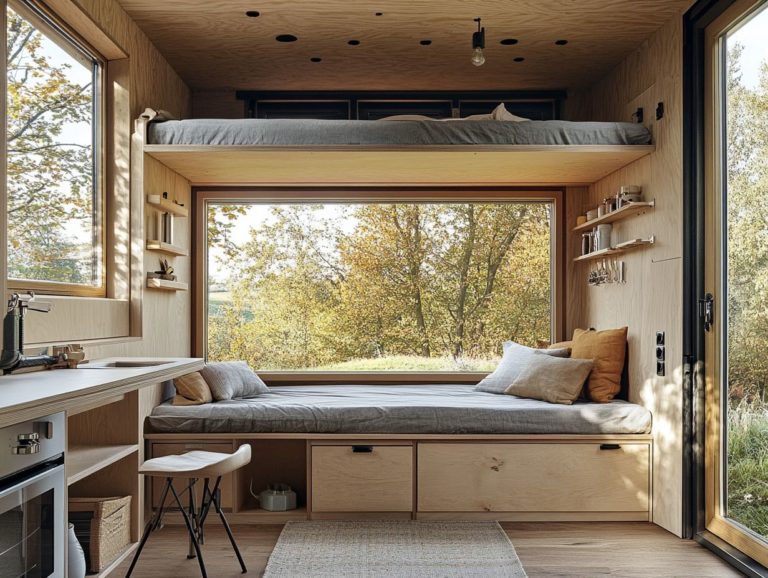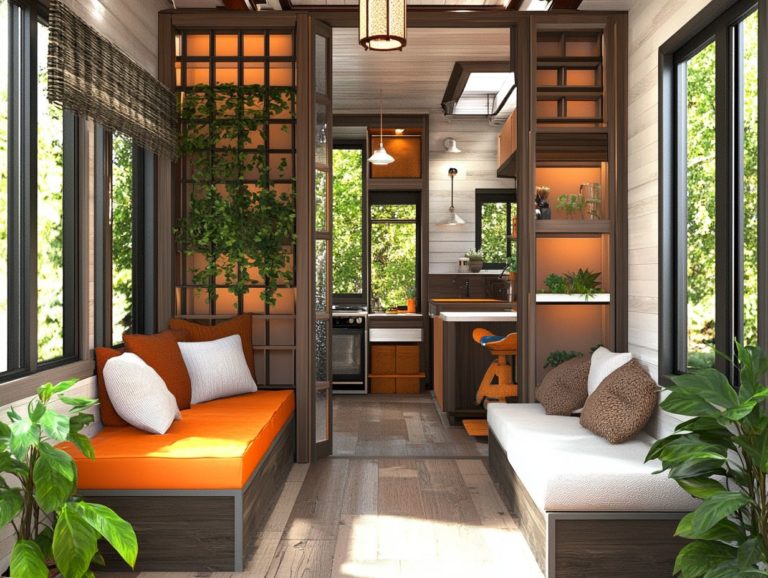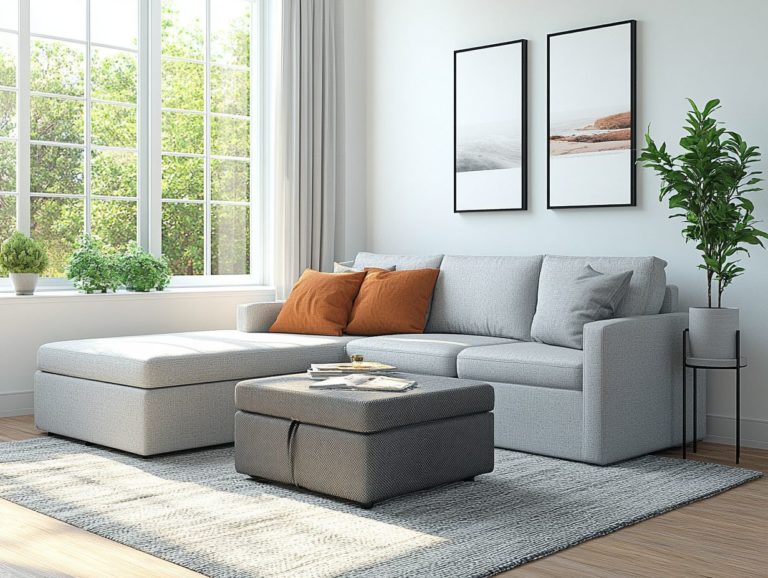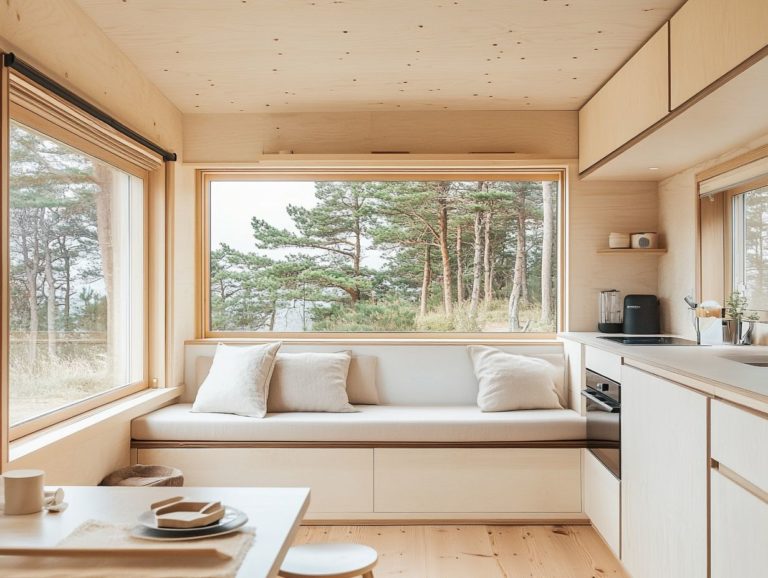Best Practices for Multi-Purpose Tiny Rooms
In today s world, where every square foot counts, multi-purpose tiny rooms, also known as multipurpose rooms, present innovative solutions that strike a perfect balance between functionality and comfort.
These adaptable spaces can easily transform into bedrooms, home offices, or intimate retreats, aligning seamlessly with your lifestyle needs.
Discover the amazing benefits of multi-purpose tiny rooms! Explore essential design tips, efficient space-saving furniture options, and clever organization strategies.
Learn how to curate a harmonious environment that feels spacious, inviting, and distinctly yours.
Contents [hide]
- Key Takeaways:
- Understanding Multi-Purpose Tiny Rooms
- Benefits of Multi-Purpose Tiny Rooms
- Designing a Multi-Purpose Tiny Room
- Choosing the Right Furniture for Multi-Purpose Tiny Rooms
- Organizing and Decluttering for Multi-Purpose Tiny Rooms
- Maximizing Natural Light and Airflow
- Frequently Asked Questions
- What are best practices for multi-purpose tiny rooms?
- How can I make a small room look bigger?
- What are some tips for creating a functional multi-purpose tiny room?
- How can I incorporate storage in a small multi-purpose room?
- How do I create separate areas in a multi-purpose tiny room?
- What are some space-saving ideas for multi-purpose tiny rooms?
Key Takeaways:
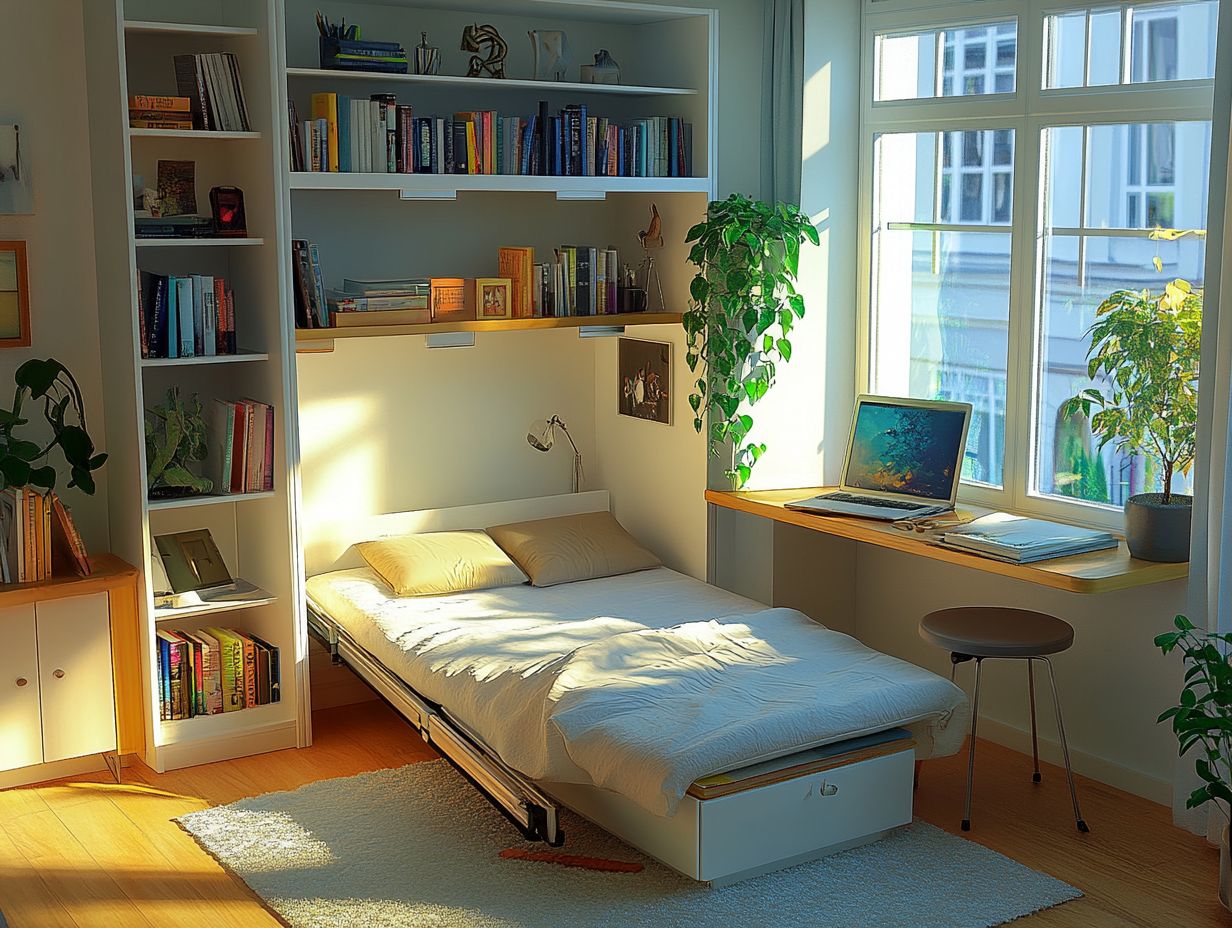
- Multi-purpose tiny rooms are compact and versatile spaces that serve multiple functions, making them ideal for small living spaces.
- Designing and furnishing multi-purpose tiny rooms requires careful consideration of space, function, and storage options.
- You can maximize natural light and airflow to create a comfortable and functional space. Utilize innovative storage solutions and versatile furniture to make the most of limited space.
Understanding Multi-Purpose Tiny Rooms
Multi-purpose tiny rooms offer innovative solutions that maximize space functionality while addressing the diverse needs of your family members. These adaptable spaces can integrate various design elements to serve multiple purposes, whether as a home office, playroom, or cozy living area.
With the surge in tiny homes, grasping the details of these rooms becomes essential for effective spatial design techniques and organization. Through thoughtful planning, you can elevate your living experience without sacrificing style or comfort.
By embracing minimalist design and implementing clever storage solutions, these rooms can thrive even in tight spots!
What are Multi-Purpose Tiny Rooms?
Multi-purpose tiny rooms, often called bonus rooms, offer you the versatility needed in a tiny home, easily adapting to functions like a home office or a kids’ playroom.
These cleverly designed spaces not only provide practical work areas but can also morph into cozy reading nooks, craft studios, or even guest bedrooms when the occasion calls for it. With innovative furniture solutions such as foldable desks (beds that fold up into the wall), Murphy beds, and modular storage, you can maximize your space while keeping everything aesthetically pleasing.
Picture this: a single room effortlessly transitions from a focused workspace for remote work during the day to an engaging area for family game nights in the evening. This level of flexibility boosts functionality and allows you to shape your living environment to fit your ever-evolving lifestyle needs.
Benefits of Multi-Purpose Tiny Rooms
The advantages of multi-purpose tiny rooms go beyond simple space efficiency; they also offer budgetary benefits that can lead to impressive savings while elevating your living experience.
These adaptable areas provide a harmonious fusion of aesthetics and practicality, especially in compact environments where every square inch matters. By implementing thoughtful design strategies and clever organization techniques, you can transform a multi-purpose room into a highly functional space that meets diverse family needs. Consider using space optimization techniques for tiny bedrooms to maximize your living area without the added cost of expanding your square footage.
Maximizing Space and Functionality
Maximizing space and functionality in multi-purpose tiny rooms calls for strategic planning and the clever use of multi-functional furniture that seamlessly adapts to various activities.
To achieve this, consider design strategies for tiny house living spaces that prioritize open layouts and intelligent zoning. For instance, a foldable dining table can magically transform a bustling meal area into a cozy sitting nook when it’s not in use.
Integrating built-in storage solutions, such as under-bed drawers or wall-mounted shelves, can significantly maintain order and keep clutter at bay. Cleverly designed ottomans that double as storage units not only provide comfort but also keep your essentials neatly tucked away.
By implementing these organization tips, you can create a harmonious living space that feels larger and more inviting, expertly balancing style and practicality.
Designing a Multi-Purpose Tiny Room
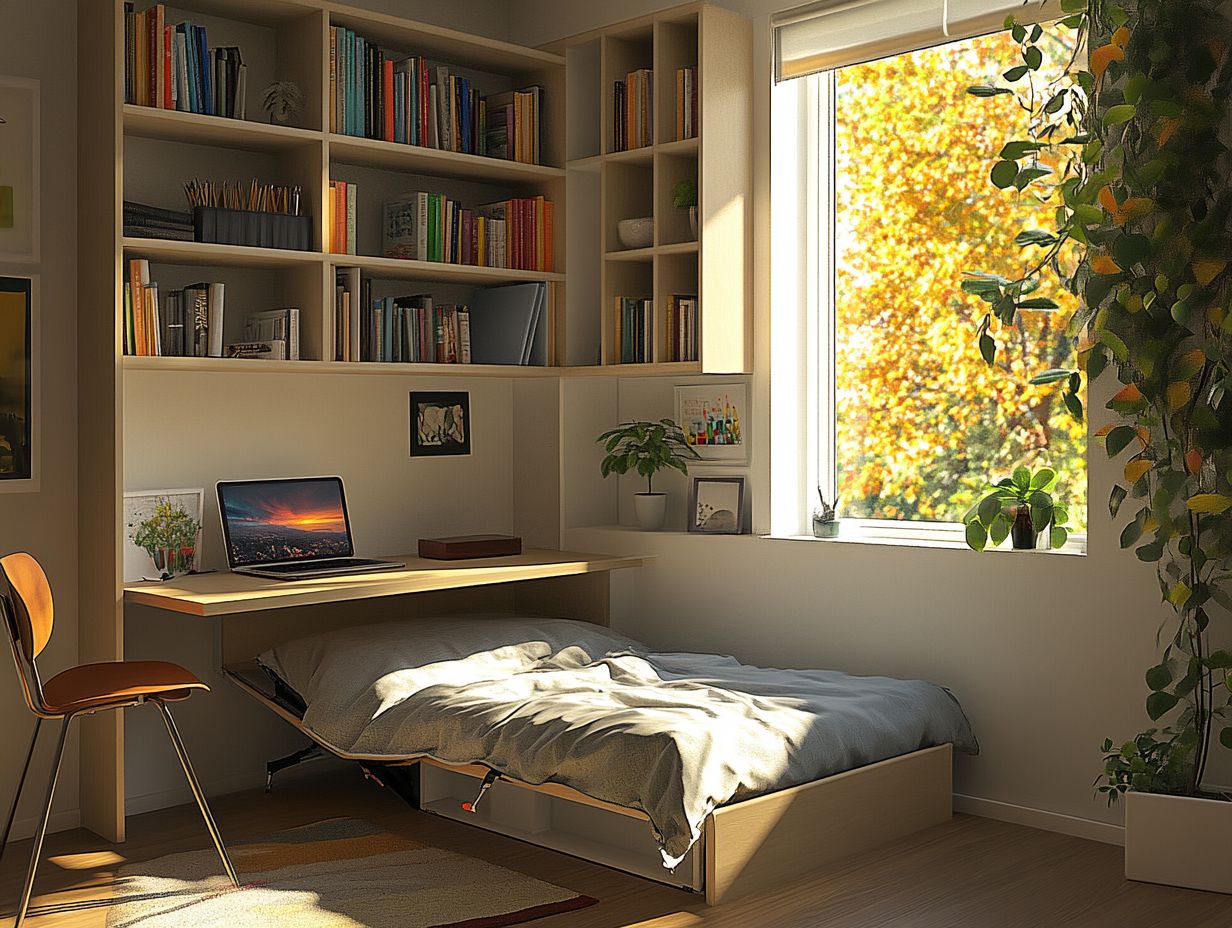
Designing a multi-purpose tiny room requires a delicate balance of creativity and strategic choices that maximize visual space while ensuring the room remains both functional and inviting.
By choosing neutral decor, you can cultivate a harmonious atmosphere that easily adapts to various uses be it for work, relaxation, or leisure.
Thoughtful interior design elements can greatly enhance your experience within the room. It is essential to incorporate decor ideas that seamlessly align with your desired aesthetic and functionality.
Key Considerations and Tips
Design your tiny room with usability and comfort in mind! Effective organization tips and the right lighting solutions are essential for creating the perfect ambiance.
Incorporating safety measures, such as securing heavy furniture and ensuring clear pathways, will not only make the space functional but also secure, reducing any potential risks.
Utilizing natural elements like plants and maximizing natural light can transform the overall feel of the room, crafting a refreshing atmosphere that promotes well-being. Consider using mirrors to amplify light and visually expand the space, while choosing colors that evoke tranquility.
Including versatile storage options is crucial for minimizing clutter and ensuring everything has its designated place, allowing your tiny room to remain inviting and organized. By embracing a thoughtful design approach, you can cultivate a space that feels cozy yet capable of meeting diverse needs, especially if you learn how to create a multi-functional tiny house.
Choosing the Right Furniture for Multi-Purpose Tiny Rooms
Selecting the perfect furniture for multi-purpose tiny rooms is crucial for maximizing space and enhancing versatility. By opting for space-saving and multi-functional pieces, you can effortlessly transform your living areas to accommodate a variety of needs.
Space-Saving and Versatile Options
Space-saving and versatile options, like wall-mounted furniture, pull-out cabinets, and floating shelves, are your best allies for maximizing storage in multi-purpose tiny rooms.
These innovative solutions effortlessly merge style and function, offering plenty of space for both everyday essentials and decorative pieces without compromising on aesthetics. Picture a wall-mounted desk providing you with a sophisticated workspace that can be neatly tucked away when you’re done. Pull-out cabinets enhance your kitchen s functionality by keeping essential tools within easy reach while maintaining a tidy appearance.
With floating shelves, you can add depth and dimension to your walls, creating curated displays that draw the eye upward, giving your space an airy feel. Each of these choices not only promotes organization but also encourages a minimalist design approach, turning compact living areas into thoughtfully designed havens of tranquility.
Organizing and Decluttering for Multi-Purpose Tiny Rooms
Organizing and decluttering multi-purpose tiny rooms is essential for creating an efficient space that harmonizes style with practicality. By incorporating clever storage solutions and hidden storage options, you can maximize every inch while ensuring your room remains visually appealing and functional.
Efficient Storage Solutions
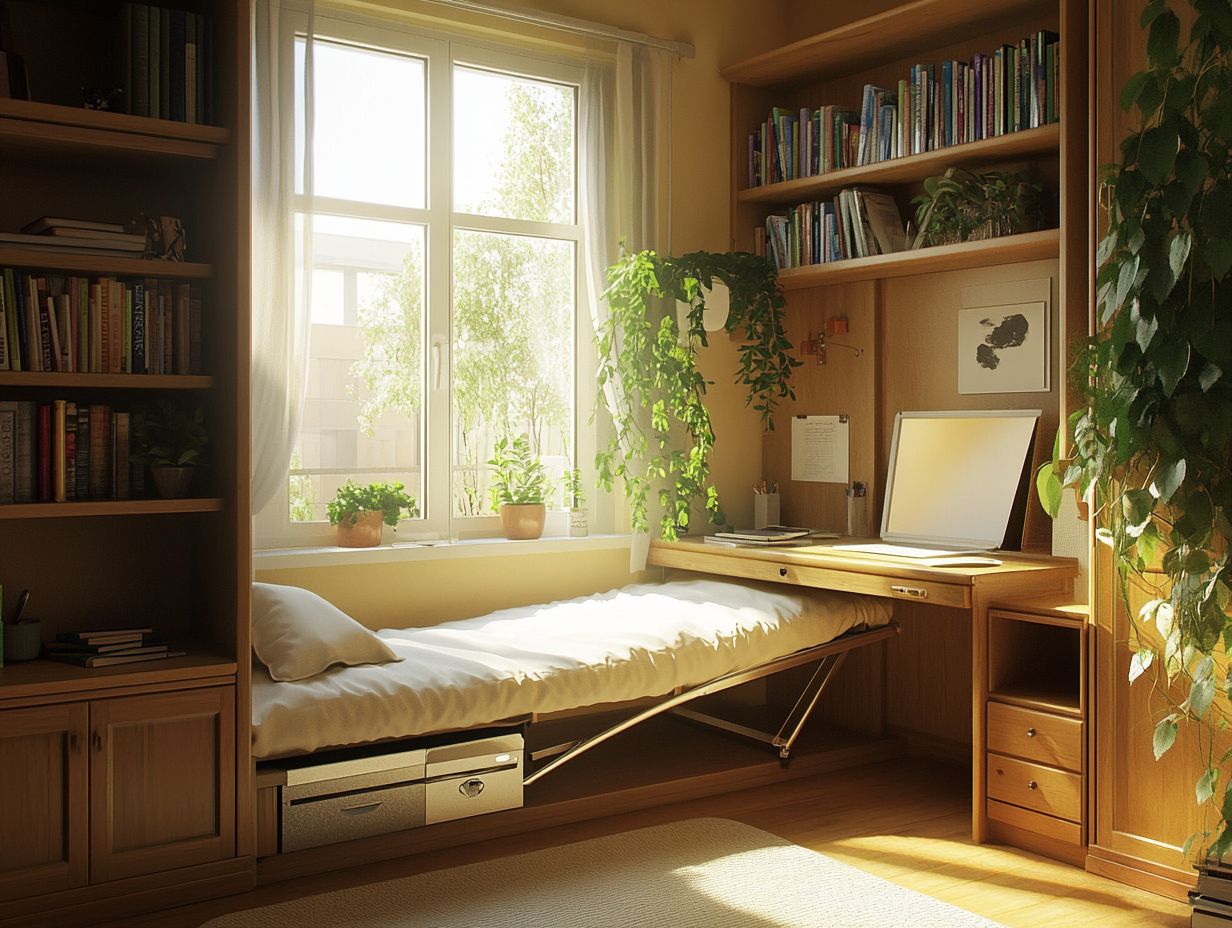
Efficient storage solutions are essential for maximizing space in multi-purpose tiny rooms, especially when you leverage vertical space and smart and clever storage strategies.
In terms of optimizing your home office nook or similar compact areas, tapping into vertical storage options truly makes all the difference. Consider incorporating wall-mounted shelves and multi-tiered shelving units that elegantly hold books, stationery, and décor while preserving precious vertical space. For more tips on maximizing small areas, check out this guide on how to create a multi-functional tiny house room.
Utilizing modular storage bins or baskets can help you maintain order and keep clutter at bay, all while seamlessly blending with the room’s aesthetic.
By combining these strategies, you can create an organized and visually appealing workspace that fosters productivity, ensuring you make the most of every square inch without compromising on style or function.
Maximizing Natural Light and Airflow
By maximizing natural light and airflow in your multi-purpose tiny rooms, you not only elevate functionality but also enrich the overall ambiance.
This thoughtful approach makes the space feel more expansive and inviting, transforming it into a haven of comfort and utility.
Strategies for Small Spaces
Implementing effective strategies for living in small spaces can truly elevate the aesthetics of your rooms, especially when you harness the power of lighting solutions and incorporate natural elements to create a cozy atmosphere.
To cultivate a warm and inviting environment, consider layering various types of lighting. Soft table lamps, twinkling fairy lights, and strategically positioned floor lamps can work wonders in adding depth and character to your space. Don t underestimate the value of dimming switches, either; they offer the flexibility to adjust brightness according to your mood or the time of day.
Integrating natural elements, like houseplants or wooden decor, can bring a refreshing touch of the outdoors into your home, fostering tranquility and a deeper connection to nature. These thoughtful adjustments have the potential to transform small areas into inviting retreats, perfect for unwinding or hosting social gatherings.
Frequently Asked Questions
What are best practices for multi-purpose tiny rooms?
1. Maximize vertical space: Utilize shelves, wall-mounted storage, and hanging organizers to make the most of limited floor space.
2. Use dual-purpose furniture: Opt for furniture with hidden storage compartments or ones that can be transformed into different pieces for different uses.
3. Keep it clutter-free: Designate a specific spot for everything and make sure to put things back in their place after use to avoid a messy and cramped space. For more tips, consider designing tiny living spaces for comfort.
How can I make a small room look bigger?
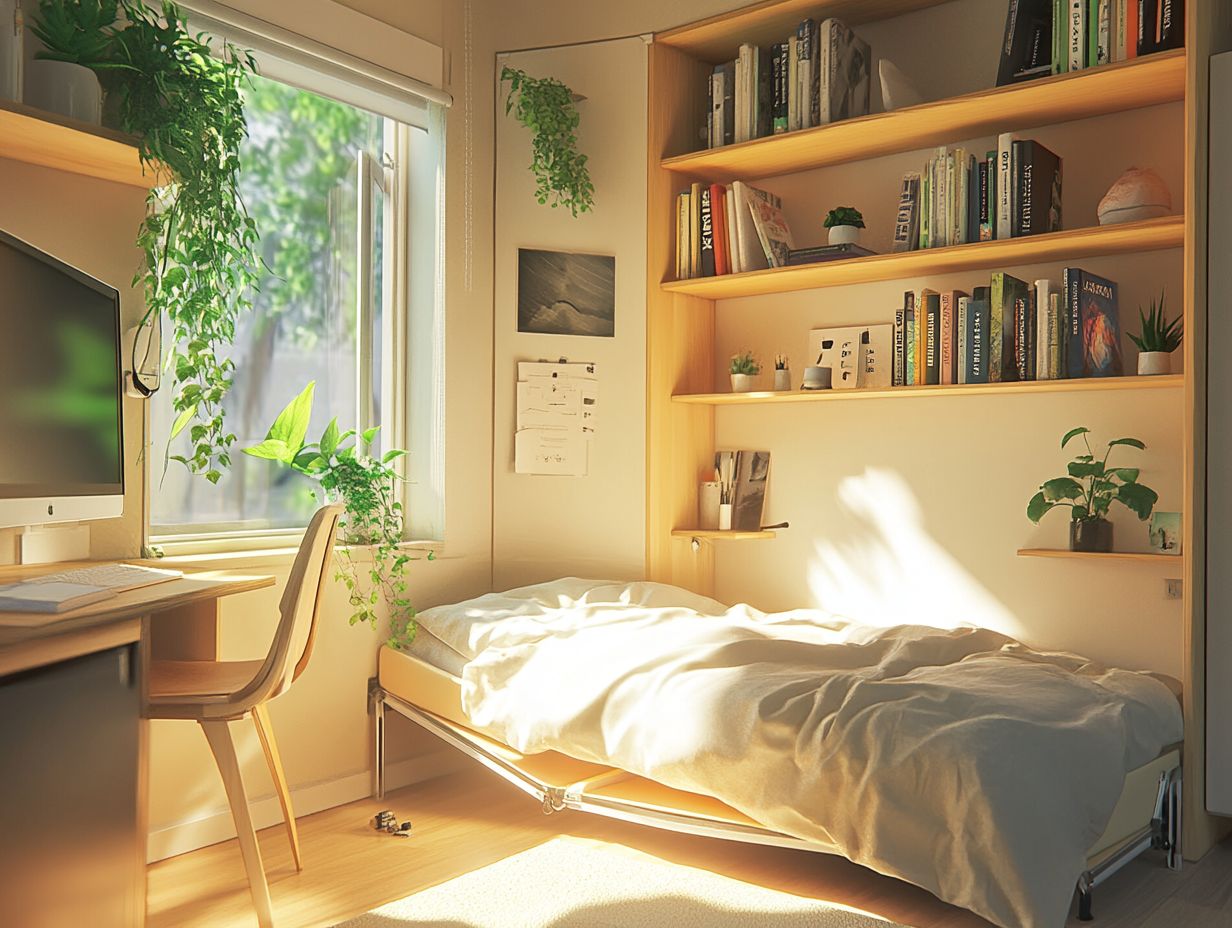
1. Use light colors: Light-colored walls, furniture, and decor can create an illusion of a larger space.
2. Utilize natural light: Keep windows unobstructed and use sheer curtains to allow natural light to flow into the room.
3. Choose furniture with exposed legs: Furniture with visible legs can make a room feel more open and spacious compared to ones that are fully covered.
What are some tips for creating a functional multi-purpose tiny room?
1. Plan ahead: Consider all the possible uses for the room and create a layout that allows for easy transitioning between activities.
2. Invest in quality pieces: Choose furniture and storage solutions that are sturdy and can withstand multiple uses.
3. Keep it versatile: Opt for items that can serve multiple purposes, such as a desk that can also be used as a dining table.
How can I incorporate storage in a small multi-purpose room?
1. Use under-bed storage: Utilize the space under your bed to store items that are not frequently used.
2. Utilize the walls: Install shelves, hooks, and pegboards on the walls to maximize storage space.
3. Hang organizers on doors: Door-hanging organizers are perfect for storing small items like shoes, accessories, and cleaning supplies.
How do I create separate areas in a multi-purpose tiny room?
1. Use curtains or room dividers. They instantly create cozy, separate spaces!
2. Use rugs. A large rug helps define areas like a living space or a workspace.
3. Choose flexible furniture. Furniture that moves easily can help set up distinct zones.
What are some space-saving ideas for multi-purpose tiny rooms?
1. Go for foldable furniture. Tables, chairs, and beds that collapse save a lot of space.
2. Use wall-mounted tables. These fold up and clear the way when not in use.
3. Utilize door space for storage. Install hooks or racks on the backs of doors for bags, jackets, or towels.

